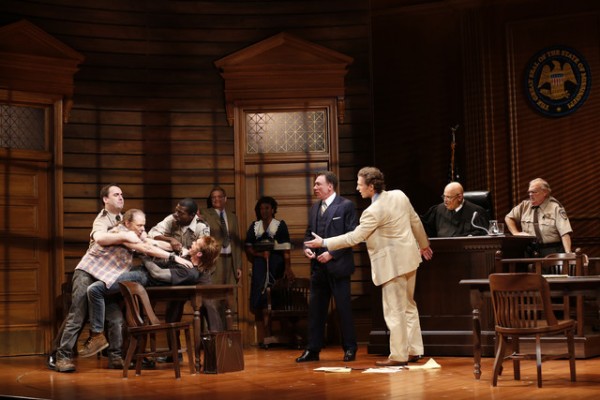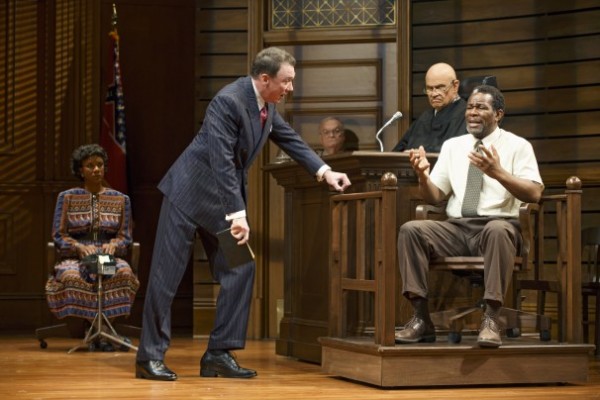
Rupert Holmes’s stage version of John Grisham novel gets off to an exciting start at Golden Theatre (photo by Carol Rosegg)
Golden Theatre
252 West 45th St. between Broadway & Eighth Ave.
Tuesday – Sunday through November 17, $49 – $132
www.atimetokillonbroadway.com
In A Time to Kill, Rupert Holmes’s adaptation of John Grisham’s 1989 debut novel, Tony winner Holmes (The Mystery of Edwin Drood) and director Ethan McSweeny set things up well in the first act, but it all falls apart very quickly in a second act that could have been called A Time to Overkill. In fictional Clanton, Mississippi, two white racists, Billy Ray Cobb (Lee Sellars) and Pete Willard (Dashiell Eaves), have just been arrested by Sheriff Ozzie Walls (Chiké Johnson) for raping and beating a ten-year-old black girl. After a bail hearing, the girl’s father, Carl Lee Hailey (John Douglas Thompson), shoots and kills both of them in the courthouse. Arrested for double homicide, Hailey hires local defense attorney Jake Brigance (Sebastian Arcelus) to represent him. With the help of law student Ellen Roark (Ashley Williams) and disbarred lawyer Lucien Wilbanks (Tom Skerritt), Brigance battles hotshot prosecutor and potential gubernatorial candidate Rufus R. Buckley (Patrick Page) to save Hailey from the death penalty. The first act flows smoothly, with short scenes and quick set changes that mimic the pace of a movie; in fact, A Time to Kill was a successful 1996 film directed by Joel Schumacher and starring Matthew McConaughey (Brigance), Samuel L. Jackson (Hailey), Sandra Bullock (Roark), Kevin Spacey (Buckley), Kiefer Sutherland (Cobb), Donald Sutherland (Wilbanks), and Charles S. Dutton (Walls).
But in the second act, which focuses on the trial overseen by Judge Noose (a stumbling Fred Dalton Thompson), unnecessary video projections, manipulative emotional twists, and an annoying conceit in which Buckley and Brigance address the audience as if it’s the jury grow tiresome. The plot and characterizations get more, well, black and white as the lines become more heavily drawn between good and bad, and any sense of nuance vanishes. Skerritt, in his Broadway debut, isn’t given much to do, and none of the actors (the cast also includes Tonya Pinkins as Hailey’s wife and John Procaccino as a drunk insanity expert) deliver standout performances as the cardboard-cutout of a story continues. Grisham fans — who very likely are in the midst of reading his brand-new novel, Sycamore Row, which features the return of Brigance — will notice the deletion of certain characters, most prominently Ethel Twitty, Harry Rex Vonner, Stump Sisson, and Carla Brigance, making for a more streamlined version, but there are better ways to kill time than by seeing this overly zealous treatment of A Time to Kill. [ed note: On November 7, it was announced that the final performance will be held on November 17. In addition, John Grisham will host the November 14 performance, discussing the original novel, the play, and the sequel, Sycamore Row.]
